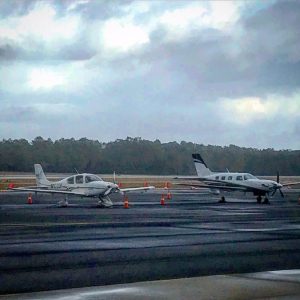
Listen to the audio version:
In the past I’ve written about the benefits of obtaining an instrument rating. But if you’re still not sure about moving forward in your training, allow me to give you some encouragement.
As a student pilot, you’ve already taken the first exhilarating steps into the world of aviation. You’ve felt the rush of takeoffs, navigated through the skies, and perhaps even executed a few graceful landings. But now, you stand at a crossroads: Should you continue your training and pursue an instrument rating? If you plan to make a career out of flying the answer is absolutely YES!
The Instrument Rating: What Is It?
An instrument rating is like adding a new dimension to your flying abilities. It allows you to operate an aircraft in conditions where visibility is limited, relying solely on the aircraft’s instruments. Whether you’re flying through thick clouds, rain, or darkness, your instrument rating equips you with the skills to navigate safely.
Why Consider an Instrument Rating?
1. Safety First
Imagine encountering unexpected weather conditions during a cross-country flight. Thick fog blankets the landscape, and you can’t see the runway. Without instrument skills, this situation could quickly become dangerous. An instrument rating provides you with the tools to handle such scenarios confidently.
2. Career Advancement
For those dreaming of a career in aviation, an instrument rating is a mandatory stepping stone. Just about every commercial flight operation require their pilots to hold an instrument rating. It demonstrates your commitment to safety and professionalism.
3. Enhanced Productivity
Even if you’re not pursuing aviation as a career, an instrument rating enhances your personal or business flying. Imagine being able to fly on days when others are grounded due to poor visibility. Your instrument skills open up new possibilities for travel and efficiency. Also, it just makes you a better pilot!

The Requirements
Before you decide, let’s delve into the practicalities. To obtain an instrument rating, you must:
- Hold a Private Pilot Certificate: If you’re already a private pilot, you’re on the right track.
- Log Flight Hours:
- At least 50 hours of cross-country flight time as pilot in command.
- 10 hours of these must be in airplanes specifically for an instrument-airplane rating.
- A total of 40 hours of actual or simulated instrument time.
- 15 hours of instrument flight training from an authorized instructor (CFII) in the relevant aircraft category.
- Cross-Country Training:
- For an instrument-airplane rating, complete cross-country flight procedures, including:
- A cross-country flight of at least 250 nautical miles along airways or ATC-directed routing.
- An instrument approach at each airport.
- Three different kinds of approaches using navigation systems (e.g., ILS, VOR, GPS).
- For an instrument-airplane rating, complete cross-country flight procedures, including:
- Preparation for the Checkride:
- Receive at least 3 hours of instrument training appropriate to the instrument rating within two calendar months before the examination date.
Training Methods
Now that you know the requirements, how should you pursue your instrument rating?
- FAR Part 141 School: Enroll in a highly regimented school that follows FAA guidelines.
- Local Instructor: Consider a full-time or part-time instructor at your local airport, also known as part 61.
- Accelerated Courses: These intensive programs can have you ready in 10 to 12 days.
Remember, the best method depends on your learning style and goals.
Final Thoughts
As you weigh your options, remember that an instrument rating isn’t just about passing a test—it’s about enhancing your skills, ensuring safety, and opening doors to new horizons. So, fellow aviator, consider the clouds your canvas, and the instruments your brush. The skies await your next adventure! 🛩️✨




Leave a Reply